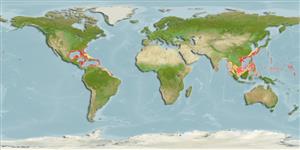Cliona varians (Duchassaing & Michelotti, 1864)
Brown variable sponge| Native range | All suitable habitat | Point map | Year 2050 |

|
| This map was computer-generated and has not yet been reviewed. |
| Cliona varians AquaMaps Data sources: GBIF OBIS |
Upload your photos
Google image |
No photo available for this species.No drawings available for Clionaidae.
Google image |
No photo available for this species.
Classification / Names Common names | Synonyms | CoL | ITIS | WoRMS
Demospongiae | Clionaida | Clionaidae
Environment: milieu / climate zone / depth range / distribution range Ecology
Reef-associated; brackish. Tropical
Distribution Countries | FAO areas | Ecosystems | Occurrences | Introductions
Western Central Atlantic and Indo-West Pacific.
Length at first maturity / Size / Weight / Age
Maturity: Lm ? range ? - ? cm
Short description Morphology
Thick encrustations that may cover several square meters substratum. Oscules are relatively large, paler and slightly elevated. May be crumbly or tough (Ref. 81728). Grows either irregularly massive, hemispheric, globular, or partly divided into irregular lobes. Encrusting patches cover 1 to 2 m in a round or semi-circular pattern. Smooth and non-porous surface with typical irregular bumps or lobes, often partly covered by sediment. Color: variously yellow, tan, green or brown. Thin encrustations may be dark green. Internally pale yellowish, with a dark brown hemispheric form with an orange interior. Spongin fibers absent. Presence of small anthosigma spicules is a unique and diagnostic characteristic (Ref. 85482).
Common on coral reefs, reef flats, seagrass beds and lagoons. Burrows in dead corals. Sporadic shallow excavations on live corals (Ref. 85482). Also in mangrove ponds (Ref. 86789).
Life cycle and mating behavior Maturity | Reproduction | Spawning | Eggs | Fecundity | Larvae
Members of the class Demospongiae are hermaphroditic. Life cycle: The zygote develops into parenchymella larva (free-swimming) before settling down on a substrate where it grows into a young sponge.
Main reference
References | Coordinator | Collaborators
Engel, S. and J.R. Pawlik. 2005. (Ref. 837)
IUCN Red List Status (Ref. 130435)
CITES status (Ref. 108899)
Not Evaluated
CMS (Ref. 116361)
Not Evaluated
Threat to humans
Human uses
| FishSource |
Tools
More information
Internet sources
BHL | BOLD Systems | CISTI | DiscoverLife | FAO(Publication : search) | Fishipedia | GenBank (genome, nucleotide) | GloBI | Gomexsi | Google Books | Google Scholar | Google | PubMed | Tree of Life | Wikipedia (Go, Search) | Zoological Record
Estimates based on models
Preferred temperature
(Ref. 115969): 21.1 - 27.5, mean 25.2 (based on 148 cells).
Price category
(Ref. 80766):
Unknown.


